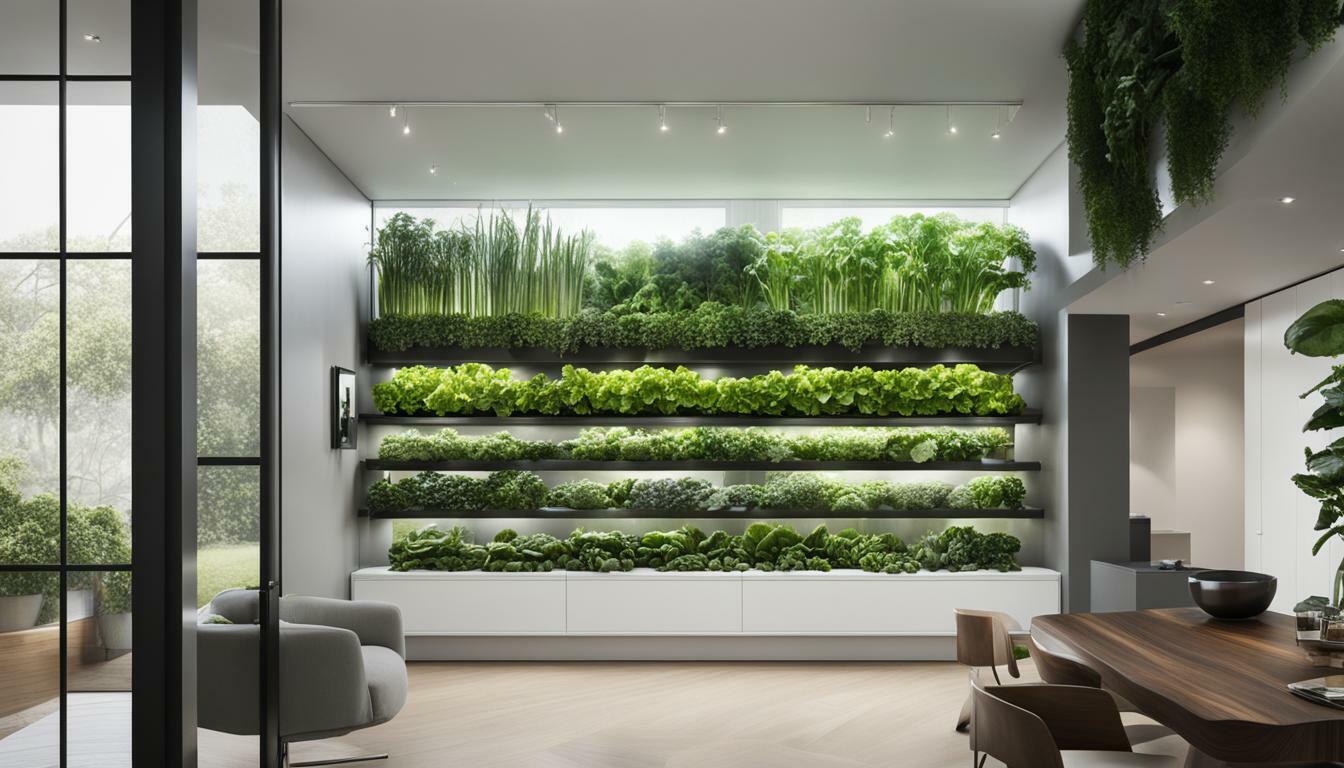Are you looking to make the most of your limited gardening space? Consider creating an indoor vertical vegetable garden! Vertical gardening is a popular technique that allows you to maximize your area by growing upwards. Whether you have a small apartment balcony or just a small window ledge, an indoor vertical vegetable garden is a creative solution to grow your own food.
With an indoor vertical vegetable garden, you can enjoy the benefits of homegrown vegetables even if you have limited outdoor space. Not only does vertical gardening help you save space, but it also offers other advantages such as easy access to fresh produce, protection against inclement weather, and the ability to experiment with different gardening techniques.
Key Takeaways:
- Indoor vertical vegetable gardens are a great way to maximize your gardening space.
- Vertical gardening allows you to grow plants upwards, utilizing walls, fences, and trellises.
- Creating an indoor vertical garden can be a DIY project using items like wall planters, gutters, bottle containers, and trellises.
- Planting vine plants and using PVC towers are other options for indoor vertical gardening.
- An indoor vertical vegetable garden offers numerous benefits, including easy access to fresh produce and protection against bad weather.
By implementing an indoor vertical vegetable garden, you can grow a variety of vegetables, herbs, and even salad greens. From wall planters and gutters to bottle gardens and trellises, there are endless DIY ideas for creating your vertical garden. These innovative gardening solutions not only save space but also add a touch of greenery to your indoor environment.
Whether you’re a gardening enthusiast or a beginner, an indoor vertical vegetable garden is a versatile and practical way to grow your own produce. So, why not start maximizing your space and enjoy the benefits of homegrown vegetables all year round?
The Benefits of an Indoor Vertical Vegetable Garden
Discover the numerous benefits of cultivating an indoor vertical vegetable garden and enjoy fresh produce year-round! Vertical gardening is a great solution for those who are tight on space or want to experiment with different gardening techniques. Whether you have a small apartment, a back porch, or just a window ledge, vertical gardening allows you to maximize your space and grow your own food.
One of the main advantages of an indoor vertical vegetable garden is its ability to make the most of limited space. In a traditional garden, plants are grown in rows, which can take up a lot of yard space. However, vertical gardening utilizes the vertical space by growing plants upwards. This technique can be implemented both indoors and outdoors, making it perfect for flower beds and maintenance. It is also a great option for those who live in apartments or have limited outdoor areas.
Another benefit of vertical gardening is the versatility it offers. With a vertical garden, you can grow a wide variety of plants, including houseplants, vegetables, annuals, perennials, and even shrubs. The possibilities are endless, and you can let your creativity run wild to design your own unique vertical garden. Additionally, vertical gardening allows for easy maintenance and weed control, making it a convenient and efficient gardening method.
“Vertical gardening is a great solution for those who are tight on space or want to experiment with different gardening techniques.”
The Benefits of an Indoor Vertical Vegetable Garden:
- Maximizes limited space
- Allows for versatility in plant selection
- Provides easy maintenance and weed control
- Offers fresh produce year-round
- Utilizes vertical space indoors or outdoors
- Great for flower beds and maintenance
As you can see, an indoor vertical vegetable garden offers numerous benefits, from maximizing space to providing fresh produce year-round. Whether you choose to create a DIY vertical garden using wall planters, gutters, or bottle gardens, or opt for trellises or PVC towers, vertical gardening allows you to enjoy the joys of gardening even in limited spaces. So start your own indoor vertical vegetable garden and reap the rewards of growing your own food!
| Benefits of an Indoor Vertical Vegetable Garden |
|---|
| Maximizes limited space |
| Allows for versatility in plant selection |
| Provides easy maintenance and weed control |
| Offers fresh produce year-round |
| Utilizes vertical space indoors or outdoors |
| Great for flower beds and maintenance |
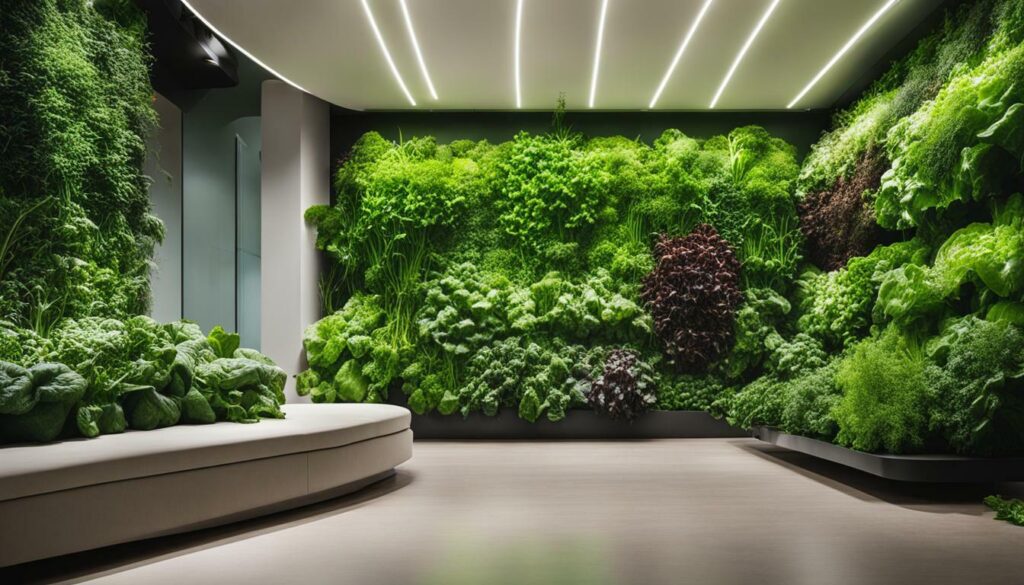
DIY Ideas for Indoor Vertical Gardens
Get creative and maximize your space with these DIY ideas for indoor vertical gardens. Whether you have a small apartment balcony or just a small window ledge, these ideas will help you turn any space into a thriving garden.
Wall Planters
One of the simplest and most effective ways to create an indoor vertical garden is with wall planters. These can be as simple as a bucket on a nail, as long as it gets enough sun and has proper drainage. Wall planters are perfect for growing herbs or greens that don’t need too much soil or space to grow. Plus, they can add a touch of greenery to any space without taking away from your outdoor area.
Gutters
Don’t let your gutters just drain water away from your home – repurpose them into the perfect vertical garden. Cut gutters to any length and attach them to the sides of your fence, shed, or house. Drill drainage holes in the gutters to prevent overwatering and allow water to drip down onto lower levels. Gutters are ideal for growing a variety of plants and can make the most of your vertical space.
Bottle Gardens
Turn plastic bottles into a DIY vertical garden that also helps reduce waste. Cut a hole in the side of a soda or water bottle and attach it to any vertical structure. Fill the bottle with soil and plant small plants like herbs and salad greens. Bottle gardens are a fun project for the whole family and a great way to utilize vertical space indoors.
Plant Vines on Your Indoor Vertical Garden
Vines are natural climbers and can be a beautiful addition to your indoor vertical garden. Morning glories or climbing hydrangeas are excellent choices that can climb over brick walls, trellises, wire fences, wooden fences, and more. They add greenery and visual interest to your space without taking up valuable floor space.
Trellises
Make use of trellises to create a vertical garden that can support your plants as they grow. Virtually anything can be turned into a trellis, such as metal poles, fences, bamboo, old scraps of lumber, and more. Just ensure that the trellis can support the weight of the plant. Trellises are perfect for growing climbing vegetables like tomatoes, cucumbers, and peas.
PVC Towers
A clever DIY option for vertical gardening is using PVC pipes to create towers. Cut out holes along the side of a thick PVC pipe, stand it up vertically, and fill with soil. Plant in the holes you made, and you’ll have an ideal garden for strawberries or other low-soil plants. PVC towers are a space-saving and efficient way to grow crops indoors.
With these DIY ideas, you can create your own indoor vertical garden and maximize your space. Whether you choose wall planters, gutters, bottle gardens, plant vines, trellises, or PVC towers, there are endless possibilities to make the most of your vertical space and enjoy the benefits of gardening indoors.
| DIY Ideas for Indoor Vertical Gardens |
|---|
| Wall Planters |
| Gutters |
| Bottle Gardens |
| Plant Vines |
| Trellises |
| PVC Towers |
Wall Planters for Indoor Vertical Gardens
Wall planters are a simple yet effective solution for growing plants vertically indoors. They are a great way to maximize your space and add a touch of greenery to any room. Wall planters can be as simple as a bucket on a nail or as elaborate as a custom-designed system. Regardless of the style, they offer several benefits for indoor vertical gardening.
One of the advantages of using wall planters is their versatility. Almost anything can be repurposed into a wall planter, allowing you to get creative and personalize your indoor garden. From mason jars to wooden crates, the options are endless. Wall planters are especially great for growing herbs or greens that don’t require much soil or space to thrive. Imagine being able to snip off fresh lettuce for your salads whenever you want.
Another benefit of wall planters is that they make weeding easier. Since the plants are growing vertically, you don’t have to bend down or crawl on the ground to pull out weeds. This saves you time and effort in maintaining your indoor garden. Plus, wall planters can be a beautiful decorative element in your home, brightening up any space without taking away from your outdoor area.
Table: Comparing Different Wall Planters
| Wall Planter | Material | Pros | Cons |
|---|---|---|---|
| Bucket on a nail | Bucket | – Easy and affordable – Can be hung anywhere | – Limited space for plants – Lack of drainage |
| Mason jar | Glass jar | – Stylish and trendy – Allows for easy monitoring of soil moisture | – Limited space for plants – Requires proper drainage |
| Wooden crate | Wood | – Provides ample space for plants – Can be customized and painted | – Requires proper drainage – May need reinforcement for heavy plants |
Whether you choose a simple bucket or a customized wooden crate, wall planters are a great option for indoor vertical gardening. They offer versatility, easy maintenance, and can enhance the aesthetics of any room. With a little creativity and the right plant selection, you can create a beautiful and productive vertical garden right on your wall.
Gutters for Indoor Vertical Gardens
Repurpose gutters to create a unique and space-saving indoor vertical garden. Gutters are not just for draining water away from your home, they can also be transformed into a vertical gardening solution. By thinking outside the box and utilizing your vertical space, you can maximize your gardening potential.
Gutters can be easily attached to the sides of your fence, shed, or even your house, providing a versatile platform for your plants to grow. The length of the gutters can be customized to fit your available space, making it an adaptable solution for any indoor environment. Ensure that there is enough space between the gutters for sunlight to reach the plants, and drill drainage holes to prevent overwatering.
One of the advantages of using gutters for vertical gardening is that they allow water to drip down onto the lower levels, ensuring that all your plants receive adequate moisture. Additionally, this method helps to conserve space, as the plants grow vertically instead of horizontally. With a well-arranged gutter system, you can cultivate a variety of vegetables, herbs, or even flowers.
Gutter Vertical Garden Ideas
Here are a few creative ideas to inspire your gutter vertical garden:
- Use different sections of gutters to create a tiered effect, maximizing vertical space.
- Plant a variety of small herbs and lettuces in individual gutter sections for a compact and convenient kitchen garden.
- Create a colorful display by planting flowers with vibrant blooms in gutters mounted on a sunny wall.
- Combine gutters with other vertical gardening solutions, such as trellises or wall planters, to create a multi-dimensional garden.
Get creative and experiment with different arrangements and plantings to personalize your indoor vertical garden. With gutters as your foundation, you can transform any indoor space into a green oasis.
| Gutter Vertical Garden Benefits |
|---|
| Maximizes vertical space |
| Allows for efficient use of sunlight and water |
| Provides a versatile platform for a variety of plants |
| Allows for easy customization and arrangement of plants |
| Creates a visually appealing and space-saving garden |
By repurposing gutters, you can bring your indoor vertical garden to life and enjoy the benefits of growing your own fresh produce and flowers in a limited space. Embrace your inner DIY enthusiast and start creating your own unique and functional gutter vertical garden today.
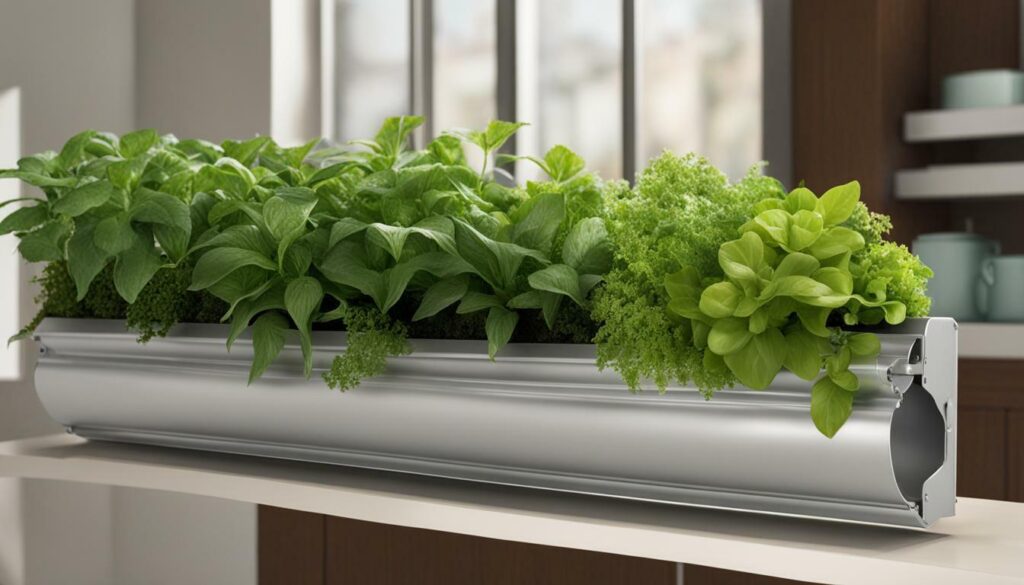
“Repurpose gutters to create a unique and space-saving indoor vertical garden.”
Bottle Gardens for Indoor Vertical Gardens
Turn plastic bottles into a sustainable and stylish indoor vertical garden. One of the best ways to maximize your space and create a beautiful green oasis is by repurposing plastic bottles into vertical planters. Not only is this a cost-effective solution, but it also helps reduce waste and supports a more eco-friendly lifestyle.
Creating a bottle garden is a simple and fun DIY project that the whole family can enjoy. All you need is some empty soda or water bottles, a vertical structure like a wooden pallet or wall, and potting soil. Cut a hole in the side of each bottle and attach them to the structure using wire or zip ties. Fill the bottles with soil and plant small herbs or salad greens. This innovative gardening technique allows you to grow plants vertically, taking advantage of unused wall space.
Bottle gardens are not only practical but also visually appealing. Arrange the bottles in a pattern or create a design using different colored bottles for a unique and eye-catching display. With a little creativity, you can transform your indoor space into a green paradise.
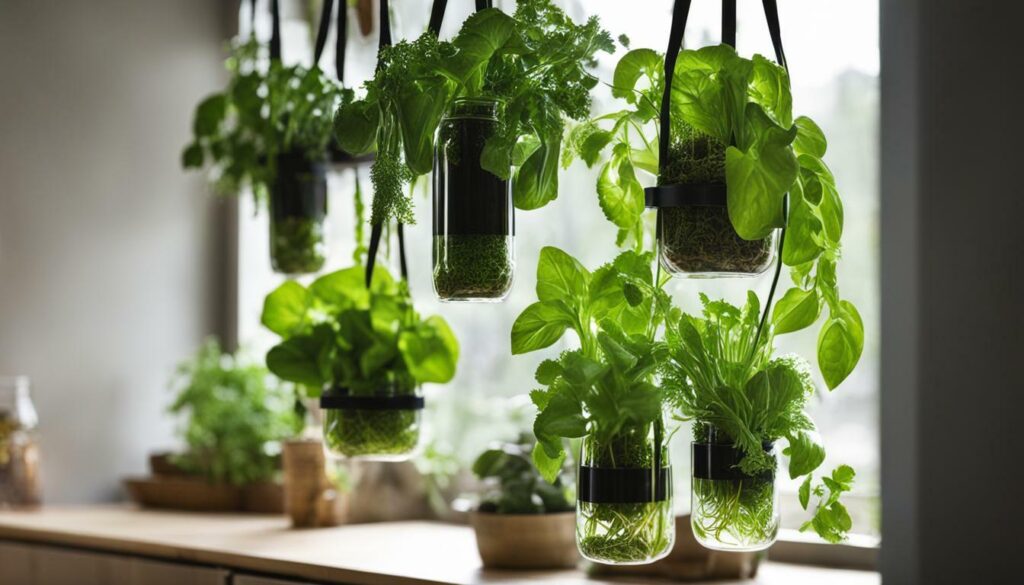
In addition to being a space-saving solution, bottle gardens offer several benefits. They provide excellent drainage, preventing waterlogged soil and reducing the risk of root rot. The compact size of the bottles also helps conserve water by reducing evaporation. Furthermore, bottle gardens are portable, making it easy to move your plants around and experiment with different arrangements.
| Advantages of Bottle Gardens for Indoor Vertical Gardens: |
|---|
| Space-saving solution |
| Cost-effective and eco-friendly |
| Excellent drainage |
| Water conservation |
| Portable |
So why not start your own bottle garden and enjoy the benefits of indoor vertical gardening? Not only will it maximize your space, but it will also add a touch of green to your home, improve air quality, and provide you with fresh herbs or salad greens right at your fingertips.
Plant Vines on Your Indoor Vertical Garden
Add a touch of nature and greenery to your indoor space by planting vines on your vertical garden. Vines are excellent choices for vertical gardening as they naturally climb and can add a beautiful aesthetic to any space. Not only do they provide visual appeal, but they also help maximize your indoor vertical garden by utilizing the vertical space effectively.
One popular vine for indoor vertical gardening is the morning glory. Morning glories are fast-growing and produce vibrant flowers that can climb over brick walls, trellises, wire fences, or wooden fences. They are versatile and can thrive in both indoor and outdoor environments. Another great option is the climbing hydrangea, which adds a touch of elegance to any vertical garden.
When planting vines on your indoor vertical garden, it’s important to ensure they have something to climb on. This can be achieved by providing trellises or other support structures that they can attach to. Trellises come in different materials such as metal poles, fences, bamboo, or old scraps of lumber. Make sure to choose a trellis that can support the weight of the vine and provide enough space for it to grow.
| Vine Plants for Indoor Vertical Gardening | Description |
|---|---|
| Morning Glory | Fast-growing vine with vibrant flowers that can climb over various surfaces. |
| Climbing Hydrangea | Elegant vine that adds beauty to vertical gardens and can climb over walls and fences. |
By incorporating vine plants into your indoor vertical garden, you not only maximize your space but also create a lush and green environment. Remember to check your USDA Hardiness Zone before planting and choose the appropriate vine plants for your region. So go ahead, plant some vines on your vertical garden and enjoy the beauty and benefits they bring!
Image: Vertical Garden with Vines
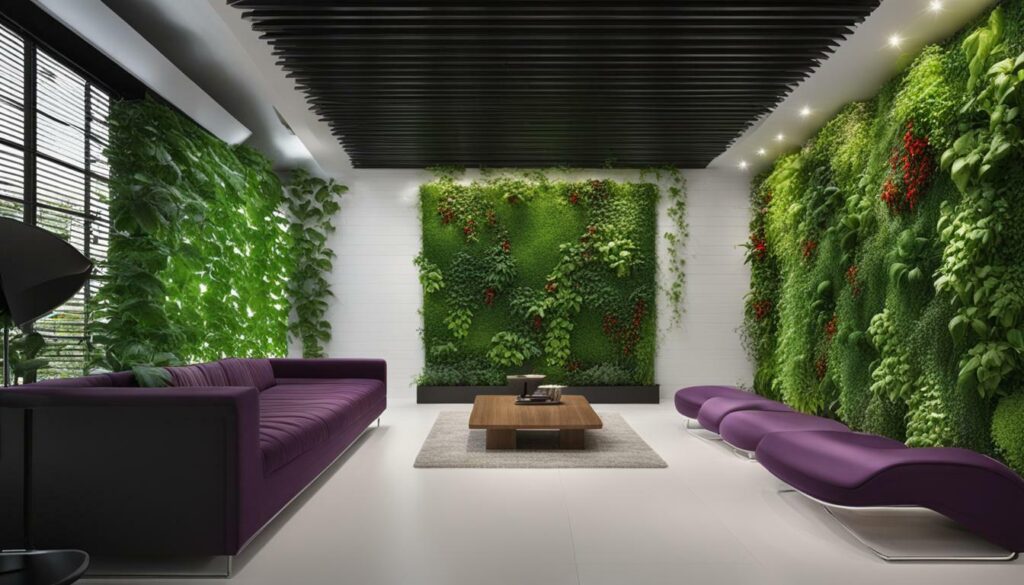
Trellises for Indoor Vertical Gardens
Create a visually stunning indoor vertical garden using trellises to support your plants. Trellises are versatile structures that can be made from various materials such as metal poles, fences, bamboo, old scraps of lumber, metal scraps, and poles. They provide a sturdy framework for your plants to climb and grow vertically, making efficient use of limited space.
Trellises are particularly beneficial for growing vine plants such as cucumbers, tomatoes, and pole beans. These plants naturally have a climbing or vining growth habit and can quickly take over garden plots if left to sprawl. By utilizing trellises, you can train these plants to grow upwards, saving valuable space in your indoor vertical garden.
When choosing a trellis for your indoor vertical garden, ensure that it is strong enough to support the weight of your plants as they grow. Consider the height and width of the trellis to accommodate the specific needs of your plants. It’s also a good idea to regularly prune and tie up your plants to keep them properly supported and prevent them from overwhelming the trellis.
Benefits of Using Trellises for Indoor Vertical Gardens
- Maximize space: Trellises allow you to grow more plants in a smaller area, making them ideal for indoor gardens with limited space.
- Improved air circulation: By training your plants to grow vertically, you create better airflow around the leaves, reducing the risk of fungal diseases.
- Easier maintenance: Harvesting, watering, and pest control become easier when plants are growing vertically on trellises, as they are more accessible and visible.
- Aesthetic appeal: A well-designed trellis can add beauty and architectural interest to your indoor vertical garden, enhancing the overall look and feel of your space.
Overall, using trellises in your indoor vertical garden is an effective way to maximize your space, improve plant health, and create a visually appealing garden. Experiment with different trellis materials and designs to find the best fit for your specific plants and aesthetic preferences.
| Vegetables | Ideal for Trellises |
|---|---|
| Cucumbers | Can climb and produce abundant fruit when supported by trellises |
| Tomatoes | Indeterminate varieties can be trained to grow vertically on trellises |
| Pole Beans | Grow upwards, producing a high yield when supported by trellises |
Remember to choose trellis materials that are sturdy, durable, and appropriate for your specific plants. With the right trellis in place, you can create a thriving indoor vertical garden that maximizes space and adds beauty to your home.
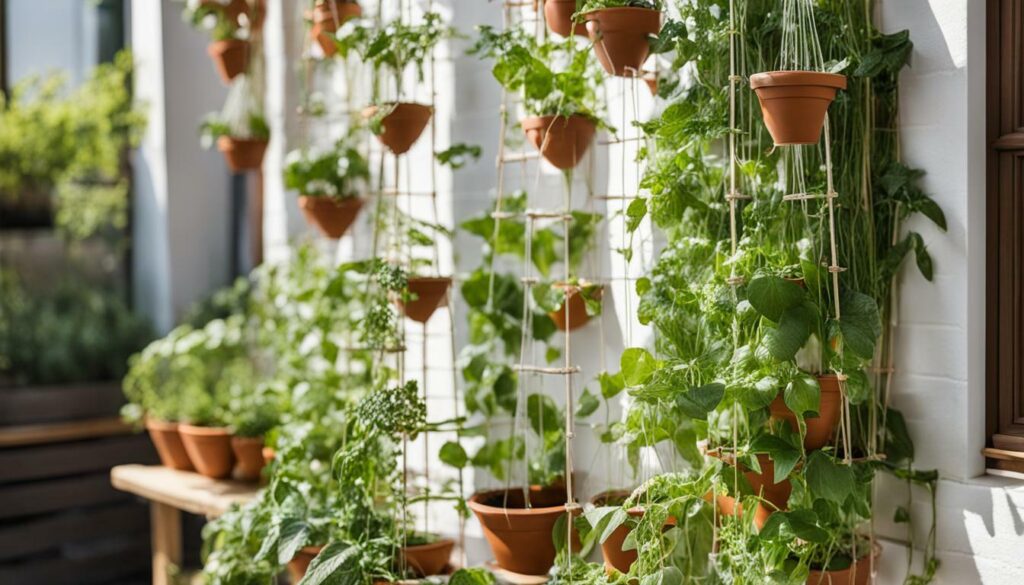
“A well-designed trellis can add beauty and architectural interest to your indoor vertical garden.”
PVC Towers for Indoor Vertical Gardens
Take your indoor vertical garden to new heights with the use of PVC towers. PVC towers are a versatile and cost-effective solution for creating a vertical garden in your home or apartment. They provide a sturdy structure for your plants to grow vertically, maximizing your space and allowing you to grow a variety of vegetables and herbs.
One of the key benefits of PVC towers is their adaptability. You can easily customize the size and design of your tower to suit your specific needs and available space. Whether you have a small balcony or a spacious indoor area, PVC towers can be built to fit and accommodate your plants.
Building a PVC tower is a simple DIY project that requires basic tools and materials. You can find PVC pipes and connectors at your local hardware store and assemble them into a tower structure. Cut out holes along the side of the PVC pipe for planting, ensuring that there is enough space for your plants to grow and receive adequate sunlight.
Once your PVC tower is built, fill it with soil and plant your desired vegetables or herbs. The vertical design of the tower allows for efficient use of water and nutrients, as they can easily flow down to the lower levels of the tower. This promotes healthy growth and reduces the risk of overwatering or underwatering your plants.
With PVC towers, you can create a stunning vertical garden that not only maximizes your space but also adds visual appeal to your indoor environment. Whether you’re a novice gardener or an experienced plant enthusiast, PVC towers offer a convenient and effective solution for growing a variety of plants in a vertical arrangement.
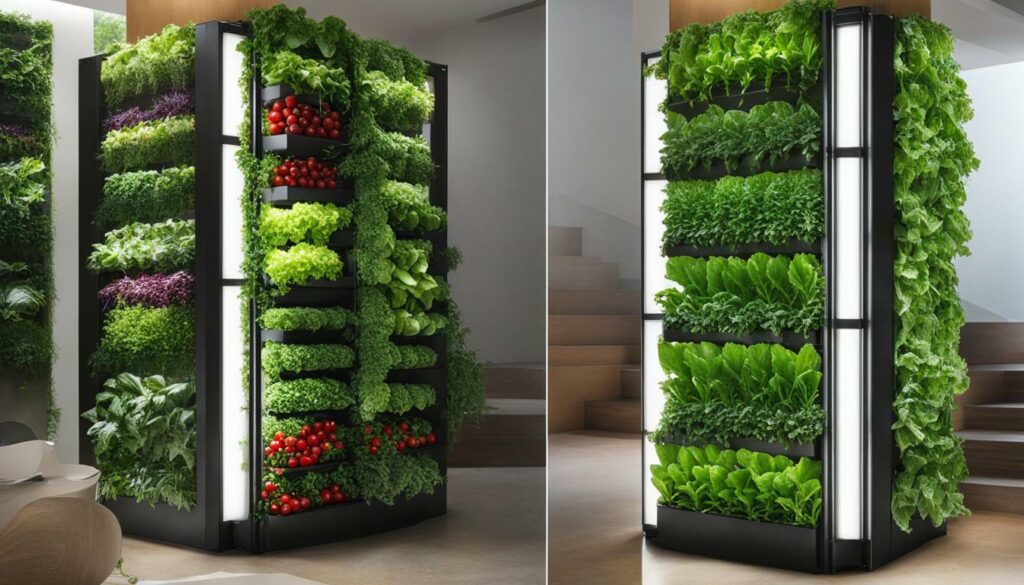
Image: PVC Tower for Indoor Vertical Garden
| Advantages of PVC Towers for Indoor Vertical Gardens |
|---|
| Maximizes vertical space |
| Customizable size and design |
| Efficient use of water and nutrients |
| Easy DIY project |
| Creates a visually appealing vertical garden |
Conclusion
In conclusion, indoor vertical vegetable gardens are a fantastic way to maximize your space and enjoy fresh produce year-round. Whether you have a small apartment balcony, a back porch, or even just a window ledge, vertical gardening allows you to make the most of your available space and grow a variety of vegetables.
One of the main benefits of vertical gardening is its ability to save space. By utilizing upwards space, you can grow a wide range of plants without the need for a large garden plot. This makes it perfect for urban dwellers or those with limited outdoor space.
There are many DIY options for creating an indoor vertical garden. From wall planters to gutters, bottle gardens to trellises, there are numerous creative and affordable ways to design your own vertical garden. These DIY projects not only maximize space but also add a unique touch to your indoor or outdoor space.
When designing your vertical garden, consider the types of plants that are best suited for this method. Tomatoes, cucumbers, beans, and herbs are just a few examples of vegetables that thrive in vertical gardens. Choose plants that have a climbing or vining growth habit to take full advantage of the vertical space.
Incorporating a vertical vegetable garden into your home not only provides you with fresh, homegrown produce but also enhances the aesthetics of your living space. With a little creativity and planning, you can create a beautiful and functional vertical garden that maximizes your space and allows you to enjoy the joys of gardening year-round.
What Are the Benefits of Using a Vertical Vegetable Garden Tower for Maximizing Space Indoors?
A vertical vegetable garden tower is a great way to maximize space indoors. It allows you to grow a variety of vegetables in a small area, perfect for those with limited space. The tower design also makes it easy to maintain and harvest your crops without the need for a large garden area.
FAQ
Q: What are the benefits of an indoor vertical vegetable garden?
A: Indoor vertical vegetable gardens allow you to maximize your space and grow plants in small areas. They also provide protection for your plants during inclement weather and can be easily accessed for maintenance and harvesting.
Q: What DIY ideas are there for creating indoor vertical gardens?
A: Some DIY ideas for indoor vertical gardens include using wall planters, repurposing gutters, creating bottle gardens, planting vines, using trellises, and utilizing PVC towers. These projects allow you to get creative and make the most of your available space.
Q: How can wall planters be used in indoor vertical gardens?
A: Wall planters are a simple and effective way to create an indoor vertical garden. They can be as simple as attaching a bucket to a wall and provide a space-saving solution for growing herbs or greens. They add a touch of greenery to any space without taking up much room.
Q: How can gutters be used in indoor vertical gardens?
A: Gutters can be repurposed into a vertical garden by attaching them to walls or other vertical structures. They provide a long window box-like space for planting, and the drainage holes allow for proper watering. Gutters are a great option for growing plants that don’t require much soil or space.
Q: How can bottle gardens be used in indoor vertical gardens?
A: Bottle gardens are a DIY project that involves cutting a hole in a soda or water bottle and attaching it to a vertical structure. These gardens are a creative way to repurpose plastic bottles and can be used for planting small plants such as herbs and salad greens.
Q: How can vines be used in indoor vertical gardens?
A: Vines are natural climbers and can be grown vertically in indoor gardens. They can climb over walls, trellises, fences, and other vertical structures, adding greenery to your space without taking up much room. Morning glories and climbing hydrangea are popular vine options.
Q: How can trellises be used in indoor vertical gardens?
A: Trellises provide support for plants to climb vertically, allowing you to make the most of your space. They can be made from various materials such as metal poles, fences, bamboo, or old scraps, and can be used to grow watermelons, pumpkins, and other climbing plants.
Q: How can PVC towers be used in indoor vertical gardens?
A: PVC towers are a clever DIY garden solution that involves using a thick PVC pipe with holes cut along the side for planting. The tower is then filled with soil and plants are placed in the holes. This type of garden is ideal for plants that don’t require much soil, such as strawberries.

